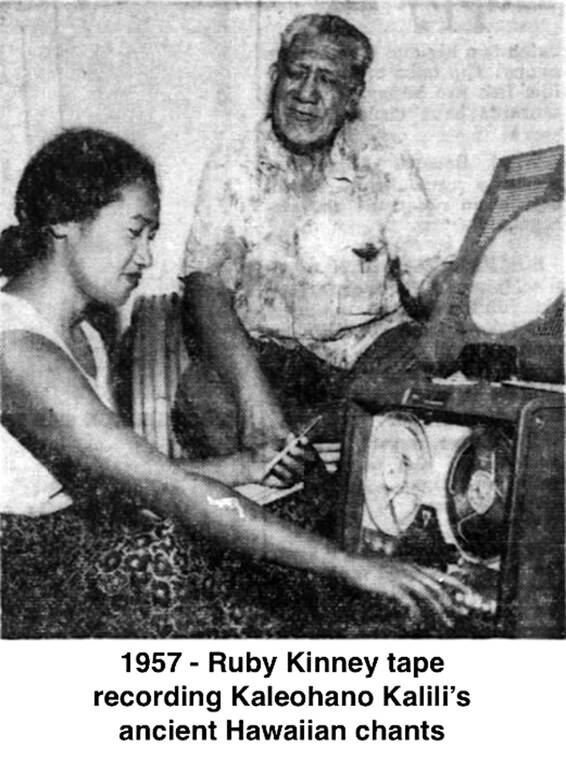Historian Rubellite “Ruby” Kawena Kinney Johnson (born in 1933), daughter of Ernest Kaipoleimanu Kinney (1906-87) and Esther Kauikeaulani Kaulili (1913-79), was born and raised on Kaua‘i and educated at Kaua‘i High School, the University of Hawai‘i and Indiana University.
Upon her return to Hawai‘i, she joined Bishop Museum under the direction of anthropologist Dr. Kenneth Emory.
Her first field job at Bishop Museum, completed in 1955, was to record oral histories of Hawaiian kupuna.
She, along with Dr. Emory, made five reels of tape recordings of Hawai‘i Island kupuna, who told them of previously undocumented traditions, legends and music, some dating back many decades, which were later transcribed and translated into English at Bishop Museum.
In 1957, Ruby continued her search for fast disappearing folklore, literature and history of the Hawaiian race.
She said at that time, “I have walked miles through the Kohala district of Hawai‘i and remote places on Kaua‘i to find people who still have priceless knowledge.”
Once again, she tape recorded Hawaiian kupuna, many nearly 100 years old, who allowed her to record their knowledge of early Hawaiiana, one of whom was Lopaka Hoomana of Anahola, then in his 90s.
Lopaka had been her father’s “kilo” or lookout man, when Mr. Kinney was a hukilau fisherman on Kaua‘i.
“In those days,” said Ruby, “when Lopaka sighted a school of fish, his whistle could be heard for three miles.”
In 1981, she published her highly regarded “Kumulipo, Hawaiian Hymn of Creation.”
Although, King Kalakaua had already printed in 1889 a 60-page pamphlet of the Kumulipo, the 2,102 lines long Polynesian creation chant — and Queen Liliuokalani had described the chant as a prayer of the development of the universe and the ancestry of the Hawaiians, and Martha W. Beckwith had published “The Kumulipo: A Hawaiian Creation Chant” in 1951 — it was Ruby’s fresh interpretation that further revealed Polynesians as having a sophisticated knowledge of evolution and a belief system linking humans, gods and the physical universe.
Ruby Johnson was also a professor in the University of Hawai‘i’s Department of Indo-Pacific Languages.
Her other works include translations of 19th century Hawaiian newspapers.






Rubelitte Kawena Johnson. Ruby is a very special friend of mine after our first meeting at the Hawaii State Advisory Committee of the U.S. Civil Rights Commission meeting, as appointed members to the Committee. We found out we were both from the Island of Kauai, and she a 1950 Kauai High School grad, where I was 1960. She was born in Koloa, and she asked me where I was born, I said Kipu and the largest smile broke from her. She then said, Kipu? She explained Kipu was her favorite place and a number of classmates and close friends were from Kipu, one was Bill Yamanaka a University Professor. I informed her that the Yamanaka’s were our neighbors in Kipu.
The major issue for the Committee was the introduction of the Akaka Legislation in D.C. and we were tasked to conduct Hearings on each of the Islands to hear from the citizens of Hawaii. We agreed that I would rent the auto and she would ride with me to each of the Hearing. We always sat next to each other at the Hearings. Over time, we shared a lot of information and about Hawaii, Kauai and friends.
Ruby was selected in 1983 as one of Hawaii’s Living Treasures and she truly was one.